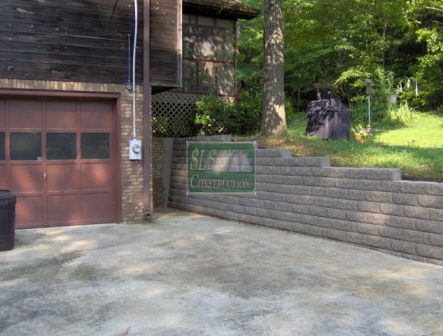 A retaining block wall can either be so simple, that a regular DIYer can complete one in an afternoon, or so complex that it requires an engineering team and a large talented construction crew months to complete one. Whether it is a small simple wall for a raised garden bed, or a large one capable of supporting a highway, they all have five things in common.
A retaining block wall can either be so simple, that a regular DIYer can complete one in an afternoon, or so complex that it requires an engineering team and a large talented construction crew months to complete one. Whether it is a small simple wall for a raised garden bed, or a large one capable of supporting a highway, they all have five things in common.
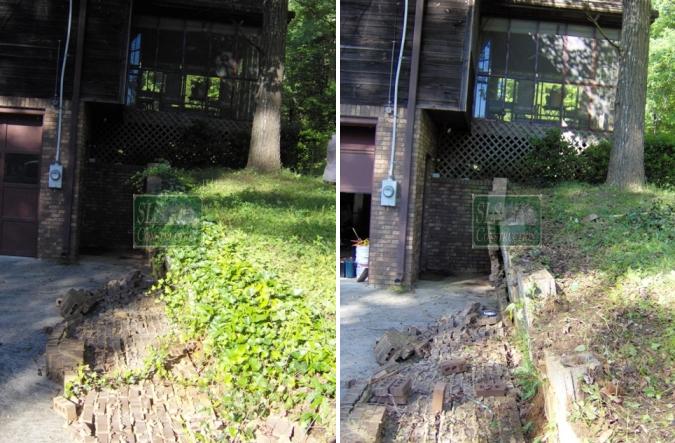
Wow, aren’t you glad your car was not parked next to that when it went? While one may first assume that the roots from that tree caused this, you would be incorrect in this case. While roots can be a major issue, that was not the case here. All this damage was simply caused by water. That is correct, water did all this damage via three natural methods – freeze-thaw cycles, settling, and the clay soil expanding as it got wet.
A proper foundation:
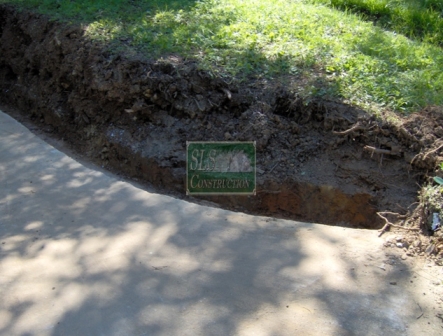 I am sure everyone has heard the parable about the man that built his house on rock & the one that built his on sand. The same is true when it comes to your retaining block wall. You foundation choices maybe dictated by your local codes but a few guidelines apply to all of them – the foundation needs to be compacted firmly and level. The top of the foundation should be below the final grade by at least 2/3 of the block height.
I am sure everyone has heard the parable about the man that built his house on rock & the one that built his on sand. The same is true when it comes to your retaining block wall. You foundation choices maybe dictated by your local codes but a few guidelines apply to all of them – the foundation needs to be compacted firmly and level. The top of the foundation should be below the final grade by at least 2/3 of the block height.
Control the water:
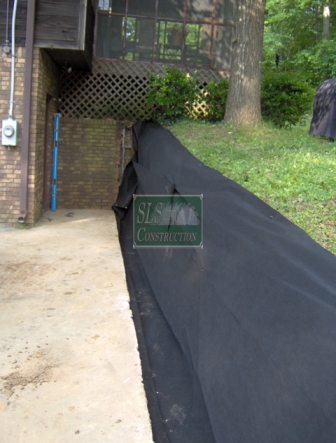 Water is the most destructive force on the earth when it comes to one’s house and / or property as we mentioned above. There are 2 main ways of controlling water – divert it before it gets there and when it does give it an escape route. In this case, we dug back a total of twice the depth of the block, added landscape fabric, added gravel & a drainage tube.
Water is the most destructive force on the earth when it comes to one’s house and / or property as we mentioned above. There are 2 main ways of controlling water – divert it before it gets there and when it does give it an escape route. In this case, we dug back a total of twice the depth of the block, added landscape fabric, added gravel & a drainage tube.
The landscaping fabric is one of the most crucial steps as it helps prevent any sand or sediment from getting into the drainage plain and blocking it up over time. I have seen plenty of walls where they used only 3 of those 4 steps and within a few years they had issues as the soil was once again blocking the drainage tube & allowing the soil to once again press against the wall, which is detrimental during the winter.
The gravel serves many purposes, most notably, as a quick drainage plain for the water to run through. If you have area’s with major expansive clay soils &/or freeze thaw cycles, it has the ability to shift – giving the wall a buffer zone. The combination of the gravel & landscape fabric also helps eliminate roots from trying to grow in that area & requiring a filter cloth along the drainage tube. While you are backfilling, you need to compact the gravel & any other back fill you need to add.
The first course:
This is the most important course you will complete. This course requires patience, care and needs to be perfectly level from side to side & front to back. In most cases, I will spend 2 to 3 times on this course as I would on each successive course. If you have done your foundation properly, this will help improve your speed, but you still need to verify it. If you have a crushed or compacted base foundation and you need to add more, make sure you compact it fully. If it happens to start settling, I have seen walls collapse because of the weight above them.
The finishing steps:
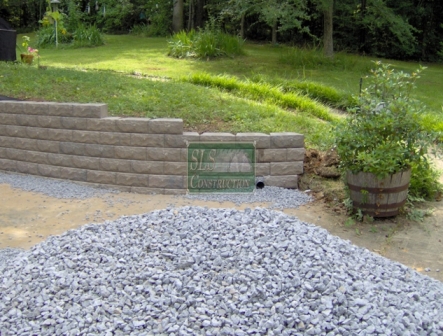 As we mentioned above in Controlling the Water, one of the best steps for preventing issues with water is to divert it. What we did in this case was to fold the landscaping fabric over & tied it into the wall block. Once we did this, we added on the final course and simply finished it off by backfilling with dirt & grass seed. We did slope the dirt towards the existing slope away from the retaining wall. In this case, the Homeowner choose not to have a cap block placed of the wall as he wanted the spaces in between for some light planting.
As we mentioned above in Controlling the Water, one of the best steps for preventing issues with water is to divert it. What we did in this case was to fold the landscaping fabric over & tied it into the wall block. Once we did this, we added on the final course and simply finished it off by backfilling with dirt & grass seed. We did slope the dirt towards the existing slope away from the retaining wall. In this case, the Homeowner choose not to have a cap block placed of the wall as he wanted the spaces in between for some light planting.
Know when to call in a Pro:
 There are 3 times we would recommend that you call in a pro. The first is if you start questioning if you should call one in because you are outside your comfort zone, not sure if you can handle the physical labor, etc… The second item is required in many areas by code, at any time your wall will exceed 4 feet in height, an engineer should be brought in. In many cases, your local codes will also require that a licensed contractor complete the work also. While you may be able to get around this by creating tiered landings, we still recommend you bring in an engineer or get a consult from a licensed contractor skilled in this arena. The final time is if there are any special considerations like it is overlooking your neighbor’s yard, there are large trees, or it will be supporting a lot of weight like a parked cars.
There are 3 times we would recommend that you call in a pro. The first is if you start questioning if you should call one in because you are outside your comfort zone, not sure if you can handle the physical labor, etc… The second item is required in many areas by code, at any time your wall will exceed 4 feet in height, an engineer should be brought in. In many cases, your local codes will also require that a licensed contractor complete the work also. While you may be able to get around this by creating tiered landings, we still recommend you bring in an engineer or get a consult from a licensed contractor skilled in this arena. The final time is if there are any special considerations like it is overlooking your neighbor’s yard, there are large trees, or it will be supporting a lot of weight like a parked cars.
As always, please stay safe; if you feel uncomfortable, do not understand how to complete a task, etc… please call in a professional. We at SLS Construction do not want to see or hear that you have been hurt or injured.

This blog mentioned the five rules or must follow steps to retain the block walls of the house. Getting such info with ease is not something that people should let go of. So I am going to follow these.